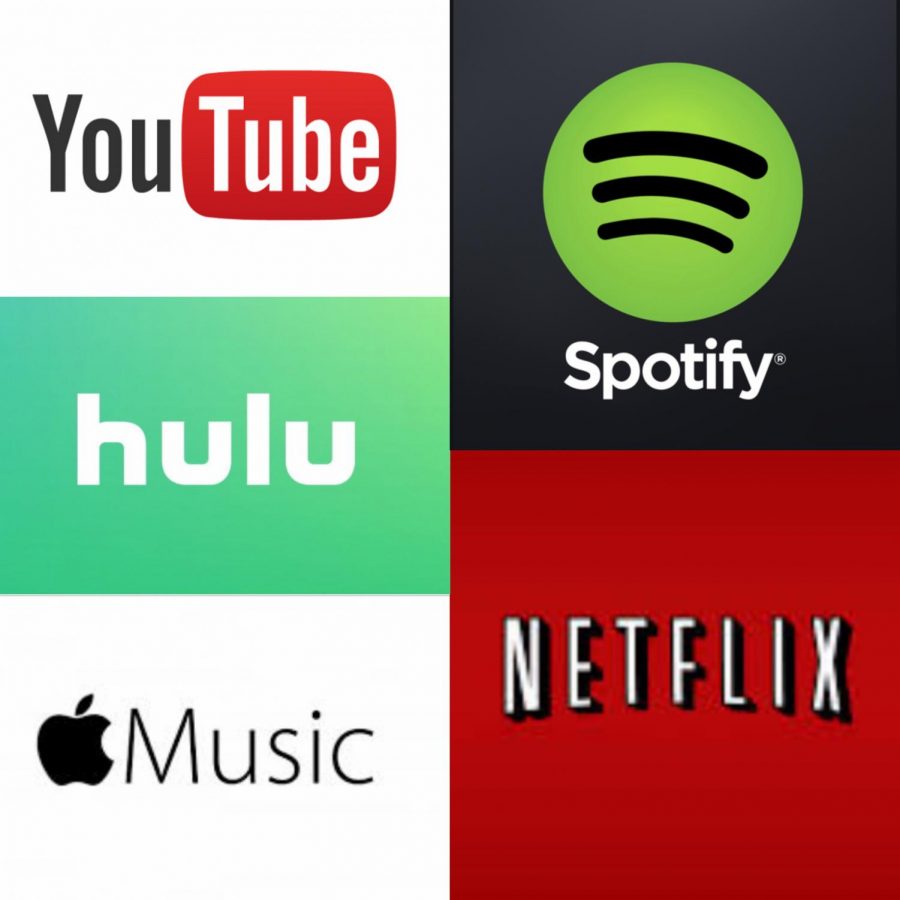The Age of Streaming
BRANCHING OUT Streaming platforms are how most people watch and listen to content. Major streaming services, including Spotify and YouTube, are beginning to reach beyond their supposed spheres into new forms of media. Some individuals are weary that these platforms are expanding too far, while others are happy to have a consolidation of media.
March 8, 2019
Streaming services have taken over how we expose ourselves to media. What once was dominated by the radio, listening to music is now primarily done through major streaming services such as Spotify, Apple Music and SoundCloud. Companies such as Hulu and Netflix have changed how we watch movies and shows, while YouTube allows people to upload constant videos. In the digital age, there seems to never be a deficit of content.
These streaming services often come with a price; Netflix charges $8.99 per month for a basic plan, $12.99 for a standard subscription, and $15.99 for a premium account. Other services are free initially, but offer premium services. Music streaming services especially offer subscriptions with additional benefits. Spotify Premium, for example, offers the ability to download music for when one is offline, the ability to play any song at any time, and no advertisements for $9.99 every month. For those who use Spotify often, the cost for Premium is worth the features it provides. Senior Susanna McIntyre uses Spotify Premium and while she used to buy songs on Apple individually, she realized that Spotify offered the same amount of music for a better price. McIntyre also uses Premium in anticipation when she enters college, as the price is slashed to $4.99 and includes a subscription to Hulu and SHOWTIME for students.
According to Investopedia, Spotify was created to “[combat] music piracy.” The Institute for Policy Innovation explained that global music piracy “causes $12.5 billion of economic losses every year. This includes 71,060 U.S. jobs lost, a loss of $2.7 billion in workers’ earnings, and a loss of $422 million in tax revenues.” The music industry thus welcomed Spotify with open arms as the company pays royalties to artists to provide music to its 191 million monthly listeners. Investopedia also explains that the major streaming service Netflix, makes its money primarily through its subscription services, yet is actually not making any money. Since 2011, Netflix has not seen a positive cash flow due to intense competition. Disney plans on taking off all of its content on the service in 2019 to create its own service and “Apple announced moves towards entertainment and original content and signed up content creators including Oprah Winfrey and Steven Spielberg.” The only way Netflix can compete is creating its own shows and movies, as well as obtaining Netflix exclusive content.
Although competition may be devastating to the major streaming companies, it is typically beneficial to the consumer. With a surplus of different options to listen to music and watch shows and movies, people are going to gravitate to those that offer the best benefits. Sophomore Olivia Huhta agrees and says, “I think it can strengthen the company and find new ways to get listeners to choose their streaming services compared to others.” As the popularity of streaming services continues to increase, companies will attempt to develop innovative ways to hook consumers.
Podcasts have also began to rise in popularity. Associated Press reported that “U.S. podcast ad revenue jumped 86 percent in 2017 to $314 million” Their unique format allows people with packed schedules to listen to something intriguing. One can find a podcast on virtually any topic ranging from politics, science, news or an entertaining story. Some individuals look to podcasts to get daily updates, while others want to have a laugh listening to others’ lives. I have a friend who drifts off to sleep while listening to a podcast that analyzes sleep. As the number of people listening to podcasts is on the steady rise, streaming services are clamoring to stake their claims. Spotify recently bought podcasting companies Gimlet and Anchor, and plans on spending “up to $500 million this year on more podcasting acquisitions,” according to CNBC. Spotify CEO, Daniel Ek, quoted by CNBC, has explained that his plan is to expand the company’s mission “‘from just being about music to being about all of audio and being the world’s leading audio platform.’” Spotify has been pushing to not only acquire podcasting companies, but also help create its own original podcasts for its service. Even though it is likely that a majority of Spotify’s podcasts will not be exclusive to the company, creating podcasts on its own platform will help initiate the medium’s development. Junior Arthur Fornia believes that it is a good idea for Spotify “because if they produce their own podcasts, that would be pretty cool and would be good quality.”
Spotify not only wants to dominate all aspects of auditory content, but also has proposed creating its own original shows. Associated Press explains, “Spotify is hoping to emulate Netflix, which has poured billions into developing original shows and movies. So far, that strategy has produced some hits such as the series ‘Stranger Things’ and the thriller ‘Bird Box.’” Spotify has already introduced vertical music videos for several popular songs, that are exclusive to the platform.
Yet there is a stigma around Spotify branching into music videos and potentially original shows and movies. Freshman Braxton Wall says, “When people think of Spotify, they think of listening. They don’t keep their phone screens on when they’re listening. I know they have music videos on Spotify, but I don’t watch them.” Spotify is perceived as an auditory service and is not thought of somewhere to watch content. It would take time to change the public’s perception, which may lead to Spotify emulating Netflix not to be successful. But Spotify is not the only platform reaching outside of its perceived sphere. YouTube, for example, has created YouTube Red or “YouTube Premium” for $11.99 a month where individuals do not get advertisements, access to YouTube Music Premium and the ability to view YouTube Originals. To some, this access to exclusive content is worth the price, but others are not used to having to pay for YouTube videos and are weary of the shift. Regardless, YouTube is raking in more revenue by expanding beyond their supposed sphere of media.
As individuals continue to devour more content, streaming services will continue to be a prominent source of media. Only time will tell if platforms branching out into various forms of content will be successful.




